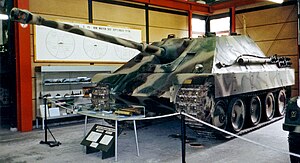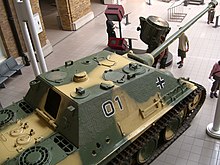Jagdpanther
| Jagdpanther | |
|---|---|
 Jagdpanzer V Jagdpanther | |
| Type | Tank destroyer |
| Place of origin | Nazi Germany |
| Service history | |
| In service | 1944–1945 (Nazi Germany) 1945–1960s (France) |
| Production history | |
| Produced | 1943–1945 |
| No. built | 415 |
| Variants | G1, G2 |
| Specifications | |
| Mass | 45.5 tonnes (100,300 lb) |
| Length | 9.87 m (32 ft 5 in) |
| Width | 3.42 m (11 ft 3 in) |
| Height | 2.71 m (8 ft 11 in) |
| Crew | 5 |
| Armor | 80 mm (3.14 in) frontal 100 mm (3.93 in) mantlet 50 mm side 40 mm rear |
Main armament | 1 × 8.8 cm Pak 43/3 or 43/4 L/71 57 rounds |
Secondary armament | 1 × 7.92 mm Maschinengewehr 34 600 rounds MG 42 600 rounds (anti aircraft) |
| Engine | Maybach HL230 P30 (V-12 petrol) 700 PS (690 hp, 515 kW) |
| Power/weight | 15.4 PS (11.3 kW) / tonne |
| Suspension | dual torsion bar |
Operational range | 200 km (99 miles) |
| Maximum speed | 46 km/h (28.6 mph) |
The Jagdpanther (German: "hunting panther"), Sd.Kfz. 173, was a highly-successful tank destroyer built by Germany during World War II based on the chassis of the Panther tank. It entered service in 1944 during the later stages of the war on the Eastern and Western Fronts. The Jagdpanther combined the 8.8 cm Pak 43 cannon, similar to the main gun of the Tiger II, and the armor and suspension of the Panther chassis.[1] During the last stages of the war, limited German production resulted in small production numbers, shortage of spare parts, and shortened crew training periods of younger operators.
Development
The Jagdpanther was preceded by two attempts at mounting an 8.8 cm gun as a self-propelled anti-tank weapon; Ferdinand using the ninety-one leftover Porsche-built VK 45.01 (P) chassis from the Tiger tank competition it lost to Henschel in 1942, and the Nashorn using a Panzer III/IV chassis. Ferdinand proved to be too heavy, and Nashorn lightly armored and under-powered.[2]
A heavy tank destroyer design based on the 8.8 cm Pak 43 gun and the Panther tank chassis was ordered in late 1942. The full-size model by Daimler-Benz was demonstrated in October 1943 before Hitler. MIAG-built prototypes followed in October/November 1943.
Production started in January 1944; in February, Hitler specified the simpler Jagdpanther name instead of its original "8.8 cm Pak 43/3 auf Fahrgestell Panther".

To accommodate the heavier-caliber gun, as on previous Jagdpanzer-style unturreted tank destroyers, the glacis plate and sloped hull sides of the Jagdpanther were extended up into an integral, turretless fixed casemate as part of the main hull to provide a roomy interior. The Jagdpanther had side plate of increased thickness (50 mm) to offset the slightly-reduced angle of the side plate to provide enough interior space. Lower frontal hull plate was reduced to 60 mm while upper hull frontal plate was kept at 80 mm. The chassis armor changes were also introduced on the main Panther tank assembly lines with the Panther Ausf. G in spring 1944.
It was armed with the long-barreled 8.8 cm Pak 43/3 L/71 gun, similar to the main gun of the Tiger II "King Tiger". The gun was mounted in a central mantlet, giving it a limited traverse of twelve-degrees to each side. A single 7.92 mm MG 34 machine gun was in a ball mount on the right side of the front glacis plate. The machine gunner was also the radio operator. The driver sat on the left. The gunner had a rangefinder and a periscope telescopic sight. The periscope – linked to the gun mount – was under an armored housing on the roof.
The Jagdpanther had a good power-to-weight ratio and a powerful main gun, enabling crews to destroy any type of Allied tank. Based on the established Panther Ausf G chassis, the vehicle encountered few mechanical problems. It was manned by a crew of five: driver, radio-operator/machine-gunner, commander, gunner, and a loader.[3]

- The two main variants can be distinguished, the earlier G1 1944 model has a small welded main gun mantlet, one piece Pak 43/3 gun, a modified Panther A engine deck, and had two vision openings for the driver. The G2 JagdPanther used a Panther Ausf. G engine deck, a larger gun mantlet bolted externally (reducing production time?), and a two piece KwK 43/4 L/71 gun. Some later G1 models enjoyed 'hybrid' G2 features such as the larger G2 mantlet as changes to the design were implemented. Zimmerit was applied to G1s up to September 1944, then was withdrawn to decrease production time. Early Jagdpanthers had two vision openings for the driver, whereas late versions had only one. The main gun originally had a monobloc gun barrel, but, May 1944-on, it was gradually replaced by an economical two-part barrel after crews determined barrel wear was uneven.[3]
Production and service
A total of 415 Jagdpanthers were produced from January 1944 by three manufacturers: MIAG in Braunschweig produced two-hundred seventy from January 1944 until the end of the war, Maschinenfabrik Niedersachsen-Hannover (MNH) produced one-hundred twelve from November 1944, Maschinenbau und Bahnbedarf (MBA) in Potsdam produced thirty-seven vehicles from December 1944.[4] Planned production was between a hundred and two-hundred a month, but the disruption to German manufacturing made this goal unachievable.[3]
The last 'production' Jagdpanthers were produced at the factory by German staff just after the end of World War II under the supervision of the Royal Electrical and Mechanical Engineers (REME). Nine Panthers and a dozen Jagdpanthers were produced, then shipped to England for evaluation. A complete Panther and a complete Jagdpanther produced this way are displayed at the Bovington Tank Museum, Dorset, with brass plates on them explaining their history.
Jagdpanther equipped heavy antitank battalions (schwere Panzerjäger-Abteilungen) and served mainly on the Eastern Front.[1] In the West, they were encountered in very small numbers late in the Battle of Normandy; the German 654 schwere Panzerjäger-Abteilung ("654th Heavy Antitank Battalion") deployed about twelve Jagdpanthers against the British armed forces. Later, significant numbers were concentrated in the West for the Ardennes Offensive.
Survivors

Three surviving Jagdpanthers are restored to running condition. Two German museums, the Deutsches Panzermuseum at Munster and the Wehrtechnische Studiensammlung (WTS) at Koblenz, each have a running Jagdpanther. The Weald Foundation in the UK restored one Jagdpanther to running condition, and has a second ready to start restoration in 2019.[5][6]
Seven surviving Jagdpanthers are displayed at:
- Bovington Tank Museum, Dorset, UK—one of those assembled by the British Army Royal Electrical and Mechanical Engineers for trials, late production model.[7]
- Imperial War Museum Duxford, Duxford, UK. Early production variant. This has three shot penetrations on the right side of the engine compartment while the left side is sectioned and opened to public view. It is rumored to be a rare casualty during the battle of Hechtel, Belgium by Hugh Griffiths, Baron Griffiths [8]. This example was previously displayed at Imperial War Museum London.
- Kubinka Tank Museum, Moscow, Russia
- Musée des Blindés in Saumur, France
- Sinsheim Auto & Technik Museum, Sinsheim, Germany
- Panzermuseum Thun, Thun, Switzerland
- Anniston Army Depot, Anniston, Alabama, USA - In storage at Center for Military History Museum Support Center - Anniston
- The Wheatcroft Collection in England owns enough parts of Jagdpanthers to restore one.[9]
See also
- SU-100
- Elefant, another enclosed German tank destroyer mounting the PaK 43.
- List of WWII Maybach engines
Notes
- ^ a b Higgins, David R. (2014). Jagdpanther vs SU-100. Eastern Front 1945. Osprey Publishing.
- ^ AFV Profile No. 10 p17
- ^ a b c AFV Profile No 10 p. 19.
- ^ Spielberger, p. 196
- ^ "Jagdpanther (8.8 cm Pak) - Sd.Kfz.173 Ausf. G2". www.wealdfoundation.org.(registration required)
- ^ "Jagdpanther (8.8 cm Pak) (Sd.Kfz.173) Ausf. G2 # 2". www.wealdfoundation.org.(registration required)
- ^ "Accession record for Museum collection".
- ^ Imperial War Museum. "Sd Kfz 173 Jagdpanther (Tank Destoyer [sic])". Imperial War Museum Collections Search. Retrieved 17 February 2012.
- ^ http://www.wheatcroftcollection.com/home.html.
References
- Spielberger, Walter, Panther & Its Variants, 1993. ISBN 0-88740-397-2
- Chris Ellis & Peter Chamberlain, AFV Profile No. 10 - Panzerkampfwagen V Panther Profile Publications.
External links
- "Jagdpanther". AFV Database. Archived from the original on 28 December 2012.
- Information about the Jagdpanther at Panzerworld
- Achtung Panzer!
- Panthers survivors—A PDF file presenting the Panther tanks (Panther, Jagdpanther, Bergepanther) still surviving


